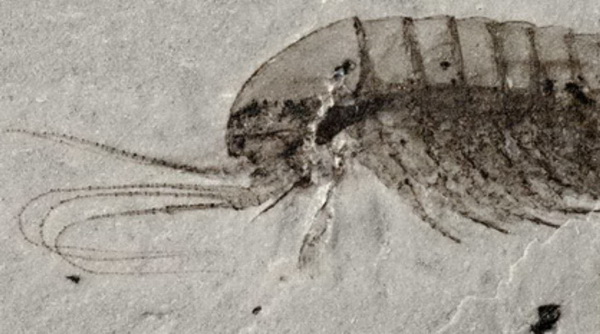Robert sent in the link to https://crev.info/2019/03/soft-tissue-in-biggest-ever-cambrian-fossil-bo… … which provides the Creationsit view of the latest discoveries. As expected they look sceptically at uniformitarian interpretations which is useful from a catastrophist point of view. After four years of research at the Chinese trove the first images are reproduced by Science magazine …
 … as one can see some delicate antennae are preserved in a shrimp like creature. It is preserved as perfectly as a fossil insect in amber – yet was chipped out of shale. The creature must have been buried in an instant. If not, the amount of detail would not have survived. This strongly indicates it was overwhelmed in a catastrophic event – and the shale (presumably a mud stone) became its cemetery. The Quingjiang biota include an abundance of squishy animals such as jelly fish, sea anemones, and comb jellies – and kinorhypths. Modern day versions of the latter can only be seen under a microscope. In the Cambrain they were much larger creatures.
… as one can see some delicate antennae are preserved in a shrimp like creature. It is preserved as perfectly as a fossil insect in amber – yet was chipped out of shale. The creature must have been buried in an instant. If not, the amount of detail would not have survived. This strongly indicates it was overwhelmed in a catastrophic event – and the shale (presumably a mud stone) became its cemetery. The Quingjiang biota include an abundance of squishy animals such as jelly fish, sea anemones, and comb jellies – and kinorhypths. Modern day versions of the latter can only be seen under a microscope. In the Cambrain they were much larger creatures.
Meanwhilpoe, at https://phys.org/print472729046.html … scientists say they have solved the mystery of the oldest animal fossils. This refers to a the Dickinsonia fossil bed – in Australia (and Russia) which has been dated from 570 to 558 million years ago – at least 40 million years older than Quingjiang. Uniformitarians had interpreted the animals as primitive life forms in the belief that the later Cambrian Exlosion represents the point when life forms burst on the scene. It seems this was due to the state of the fossils – and not strictly down to idealogy trumping observation. Again, these are soft bodied creatures living on the sea floor. What is seen as fossilised is not necessarily what the creatures actually looked like. The moputh and guts are missing for a start and although soft parts have been preserved they are in no way comparable to the creatures from Quingjiang.
